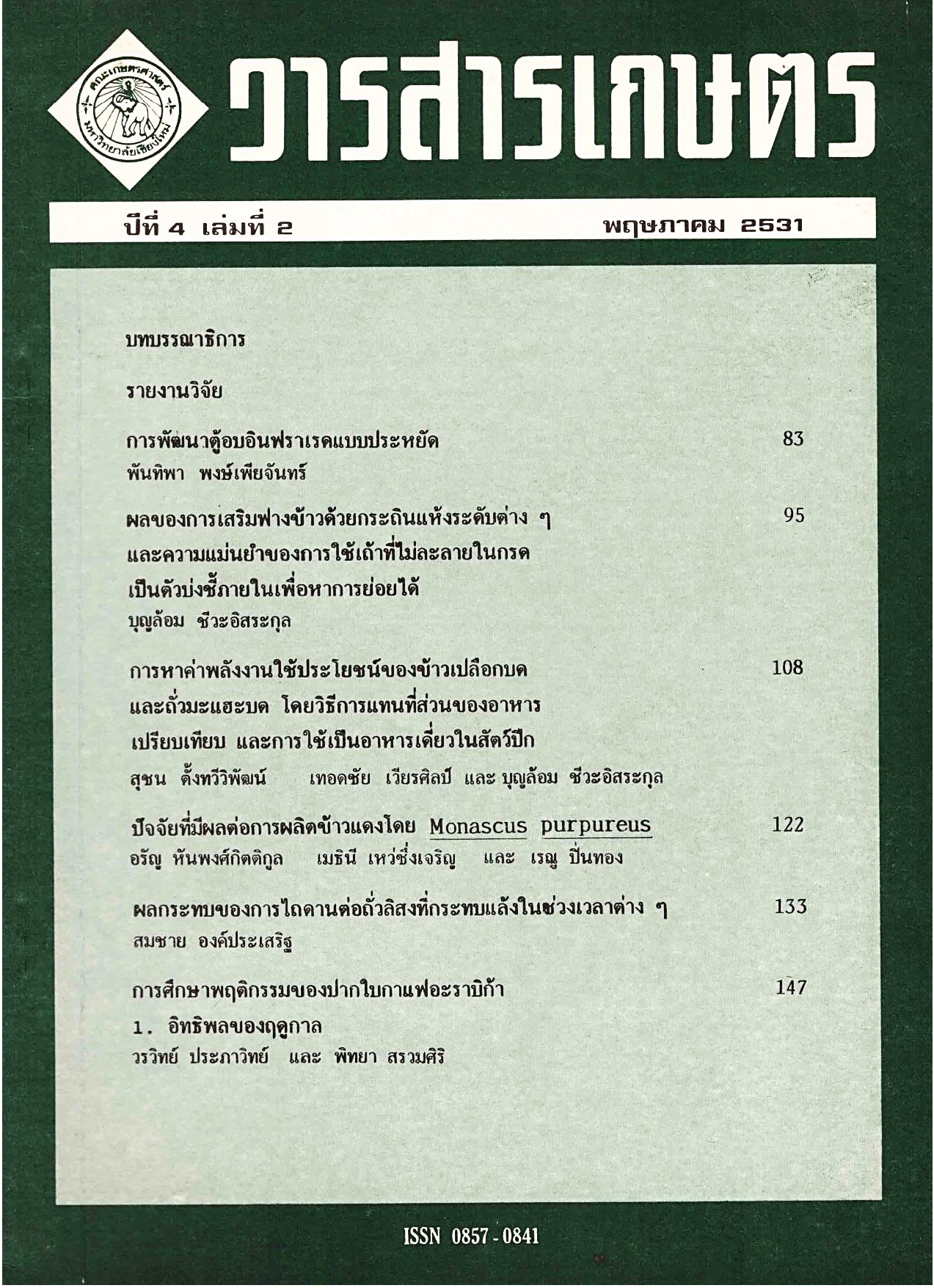METABOLIZABLE ENERGY VALUE OF GROUND PADDY AND GROUND PIGEON PEA DETERMINED BY REGRESSION AND SINGLE FEEDING METHODS IN POULTRY DIETS.
Main Article Content
Abstract
Metabolizable energy value of paddy rice using 4 laying hens and of pigeon pea using 4 adult cockerel broilers were determined by replacement of test meterial in basal diet at 0, 15, 30 and 45 %. This technique was compared to the single feeding method using regression analysis trial, 5 day preliminary period was followed by 4 day collection period during which the amount of feed intake and excreta were collected quantitatively once a day at 11.00 A.M. and determined for DM and gross energy. The results indicated a stepwise reduction in metabolizable energy of the diets as proportion of ground paddy or ground pigeon pea increased. Metabolizable energy value of paddy rice calculated by regression was 8.779 comparing to 10.593 KJ/g as determined by single feeding. method while the estimated value for pigeon pea was 7.805 comparing to 5.725 KJ/g, obtained from the single feeding method. Since negative and possitive associative effect have been found in ground paddy and pigeon pea respectively, it is suggested that regression method is suitable for ME determination of both feedstuffs than single feeding method. An alternative method for the regression should be the substitution of test material at 40% of basal diet.
Article Details
References
Armsby, H.P. (1917). The nutrition of farm animals. In P.J. Van Soest. (1982). Nutrition ecology of the ruminant, Oregon: O& B Books. Inc.
Campbell, G.L., Campbell, L.D. and Blair, R. (1983). Calculation of metabolizable energy for ingredients incorporated at low levels into a reference diet. Poultry Sci. 62: 705-707.
Farrell, DJ. (1978), Rapid determination of metabolizable energy of feeds using cockerels. Br. Poultry Sci. 19:303-308.
Jambunathan, R. and Singh, U. (1980). Grain quality of pigeon pea. In Proceeding internation workshop on pigeon peas. ICRISAT, Patancheru, India. Vol. 1, pp 351-356.
McIntosh, J.I., Slinger, S.J. Sibbald, I.R. and Ashton, G.C. (1962). Factors affecting the metabolizable energy and grit feeding on the availability of the energy of wheat, corn, oats and barley. 8. A study on the effect of die tary balance. Poultry Sci. 41: 445–456.
Miller, W.S. (1974). In Energy requirements of poultry, p. 91. Eds. T.R. Morris and B.M. Freeman. Edinburgh: British Poultry Science,
Potter, L.M., Matterson, L.D. Arnold, A.W.,Pudelkiewicz, W.J. and Singsen, E.P. (1960). Studies in evaluating energy content of feeds for the chick. I. The evaluation of the metabolizable energy and productive energy of alpha cellulose. Poultry Sci. 39:1166-1178.
Pryor, W.J. and Conner, J.K. (1966). In Recent advances in animal nutrition-1979 (Studies in the agricultural and food sciences) pp 38-39. Eds. W. Haresign and D. Lewis. London: Butterworths.
Sibbald, I.R., Summers, J.D, and Slinger, S.J. (1960). Factors affecting the meta bolizable energy centent of poultry feeds. Poultry Sci. 39 : 544-556.
Sibbald, I.R. (1975). The effect of level of feed intake on metabolizable energy values measured with adult roosters. Poultry Sci. 54:1990-1997.
Sibbald, I.R. (1979). Metabolizable energy evaluation of poultry diets. In W. Haresign and D. Lewis. Recent advances in animal nutrition. (1979). (Studies in the agricultural and food sciences) London. Butterworths.
Vistipanich, T., Batterham, E.S. and Norton, B.W. (1985). Nutritional value of chickpea (Cicer arietinum) and pigeon pea (Cajanus cajan) meals for growing pigs and rats. I. Energy content and protein quality. Aust. J. Agric. Res. 36: 327-335.


